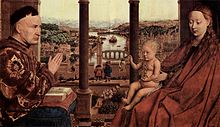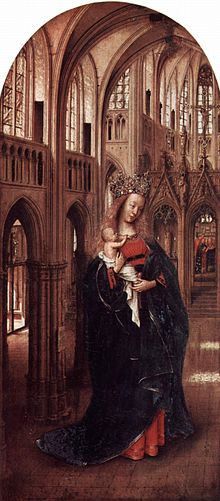Lambertus Cathedral (Liège)
The Lambertus Cathedral (real name: Cathédrale Notre-Dame-et-Saint-Lambert ) was the cathedral of Liege until 1794. The large Gothic cathedral consecrated to Bishop Lambert stood on today's Place Saint-Lambert in the center of the city. With two choirs, two transepts, three longitudinal aisles, the chapels wreath , its cloister with the annexes and the 135 meter high tower, Notre-Dame-et-Saint-Lambert was the medieval church with the largest interior space in Western Europe, which could accommodate 4,000 people. The cathedral was demolished in the wake of the French Revolution at the instigation of Liège revolutionaries .
history


Bishop Lambert of Maastricht was murdered in Liège in 705. He was buried in Maastricht , but then, when the place of his murder became a destination for pilgrims, he was reburied by his successor Hubertus in Liège. A little later, the bishopric was moved from Maastricht to Liège. In April 714 the caretaker Grimoald from the Arnulfinger family was slain in the Lambertus Cathedral .
The mausoleum built by Hubertus was unusually oriented to the west, which is why the choir is also oriented to the west in the subsequent buildings. The first of these buildings dates from the end of the 8th century and was Carolingian style .
In 978, Bishop Notger installed a cathedral chapter with 60 canons , around the year 1000 he began building a new church in the Ottonian style with a crypt for the relics of the saint. The new cathedral had a massive westwork , two choirs at the opposite end, two transepts with a tower over the crossing . A cloister complemented the church building. The entrances to the church were on the north and south sides and not on the longitudinal axis of the building. In the years 1140 to 1180 a number of alterations were made to the cathedral.
The excommunicated Emperor Henry IV , who died in Liège on August 7, 1106, got his first resting place in the cathedral. After objections by the bishops, the body was removed from his grave and buried in unconsecrated earth in a still unconsecrated chapel outside the city in Cornelio monte sita (today Cornillon, a district of Liège). A little later, Heinrich V disregarded the decision of the princes, had the body taken out of the ground again on August 24 and transferred first to Liège and then to Speyer .
On the night of April 28-29, 1185, a fire broke out near the cathedral, spreading to the cloister and the church building, and destroying both. The reconstruction on the basis of the old foundations, which began immediately afterwards, was carried out in the Gothic style and led as early as 1189 to the consecration of the at least partially restored church by Philipp von Heinsberg , the Archbishop of Cologne. In 1197 the Lambertus relics, which had been brought to safety from the fire, could be brought back to the cathedral.
A lack of capital subsequently hindered the completion of the building. Processions were held throughout the diocese to raise money. Pope Innocent IV (1243–1254) promised indulgences to everyone who helped with the reconstruction. In 1391 the construction of the 135 meter high tower began, the completion of which in 1431 marked the end of major work on the cathedral.
The cathedral was 96 meters long, the entire complex including the monastery was 173 meters, and with the side chapels 37 meters wide. The interior was about 30 meters high. In architectural style, not in size, it was comparable to Notre-Dame de Paris . The two sandstone towers on the west facade were similar to those of the cathedral in Brussels and the Church of Our Lady in Breda and Tongeren .
Blaeu , Liège, detail
Remacle Le Loup , Lambertus Cathedral, around 1735
destruction
In 1794 , during the French Revolution, the demolition of the cathedral began because for the Liège revolutionaries the cathedral was the symbol of the reign of the Prince-Bishop . Under the supervision of a "Commission destructive de la cathédrale" the lead roofs were covered (the metal was needed by the military), in 1795 the demolition of the large tower began, in 1803 the two towers on the facade were destroyed. Almost the entire complex was leveled in 1827, with the exception of the construction hut between the cathedral and the bishop's palace, which remained in place until 1929.
After the revolution subsided, the population looked for replacements and chose the Saint-Paul Collegiate Church as the church closest to the city center. Today it is the Liège Cathedral .
Jean-Noël Chevron , ruins of the cathedral,
Jean-Auguste-Dominique Ingres , “Bonaparte, Premier Consul” (1804, Grand Curtius, Liège) - in the background the intact cathedral, which in 1804 was largely destroyed
literature
- Joseph Philippe: La Cathédrale Saint-Lambert de Liège. Gloire de l'Occident et de l'art mosan. Wahle, Liège 1979, ISBN 2-87011-049-9 .
Web links
Remarks
- ^ Jean Lejeune: Vers une Résurrection des Réalités: La période liégeoise des Van Eyck. In: Wallraf-Richartz-Jahrbuch. Vol. 17, 1955, ISSN 0083-7105 , pp. 62-78, JSTOR 24655212 .
Coordinates: 50 ° 38 ′ 43.8 " N , 5 ° 34 ′ 26.5" E











